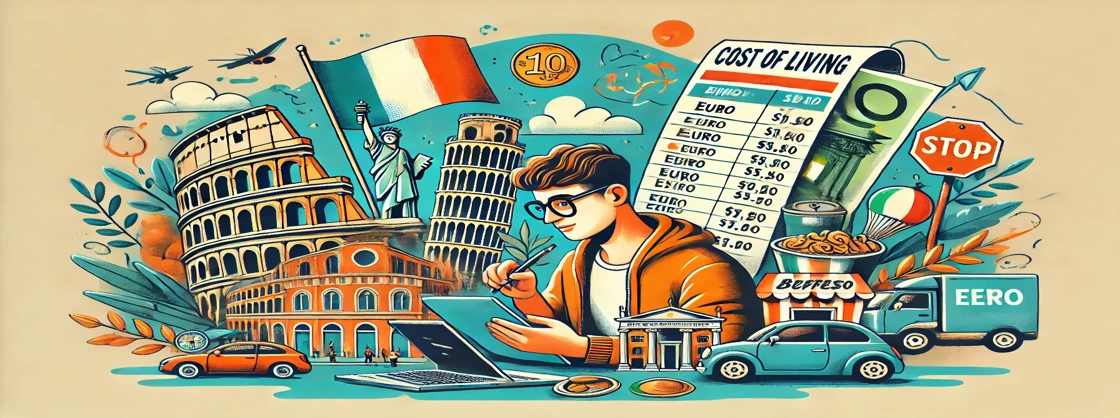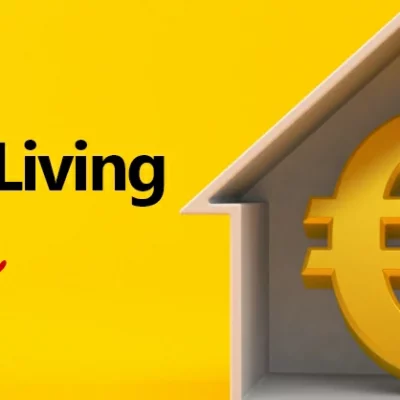Cost of living in Italy for International Students 2025: A Comprehensive Guide
Table of Contents
Studying in Italy is an exciting journey filled with cultural, academic, and social experiences. However, understanding the cost of living in Italy for international students is vital for budgeting and making the most of your stay. This comprehensive guide will break down the living expenses in Italy for international students, including a city-wise analysis of costs. Whether you’re an Indian student or an international scholar, this guide will give you a clear picture of Italy’s affordability.
Average Cost of Living in Italy for International Students 2025
Italy offers a perfect mix of cultural charm and quality education, making it a top destination for international students. However, understanding and managing living expenses in Italy for international students is crucial for a seamless study experience. On average, students spend between €700 and €1,200 per month, depending on their city of residence and lifestyle. Below is a breakdown of typical costs:
| Expense Category | Monthly Cost (EUR) |
| Accommodation | €250–€700 |
| Food and Groceries | €150–€300 |
| Transportation | €25–€50 |
| Utilities and Internet | €50–€100 |
| Leisure and Miscellaneous | €100–€200 |
| Total | €700–€1,200 |
Cost of Living in Italy: City Wise 2025
The cost of living varies significantly across Italian cities. Metropolitan hubs like Milan and Rome are on the higher end, while smaller cities like Bologna and Turin are more affordable. Here’s a detailed comparison of the cost of living in Italy for international students across major student cities:
| City | Accommodation (EUR) | Food (EUR) | Transport (EUR) | Total Monthly Cost (EUR) |
| Milan | €400–€800 | €200–€350 | €50 | €950–€1,500 |
| Rome | €350–€700 | €180–€300 | €35 | €900–€1,350 |
| Bologna | €300–€600 | €150–€280 | €30 | €800–€1,200 |
| Turin | €250–€500 | €150–€250 | €25 | €700–€1,000 |
| Naples | €200–€450 | €150–€250 | €25 | €700–€1,000 |
| Florence | €300–€600 | €180–€300 | €35 | €850–€1,200 |
Cost of Accommodation in Italy 2025
Accommodation is often the largest expense for international students in Italy. Housing options vary based on the city, type of accommodation, and proximity to universities:
- University Dormitories: These are affordable and located close to campuses, fostering a community environment. However, availability is limited.
- Private Rentals: Ideal for privacy, private apartments are more expensive, especially in cities like Milan and Rome.
- Shared Apartments: A budget-friendly option, shared flats allow you to split costs with other students.
Here’s a breakdown of average monthly accommodation costs in Italy for international students:
| Accommodation Type | Monthly Cost (EUR) | Remarks |
| University Dormitories | €250–€400 | Affordable but limited availability. |
| Private Apartments | €600–€1,200 | Higher costs in cities like Milan and Rome. |
| Shared Apartments | €300–€700 | Ideal for cost-sharing among students. |
Cost of Transportation in Italy 2025
Italy’s efficient public transportation system makes it easy for students to navigate their city and explore the country. Following are the various modes of transports that most students use to travel:
- Public Transport: Cities like Rome, Milan, and Florence offer comprehensive networks of buses, metros, and trams.
- Trains: Regional trains are ideal for intercity travel, while high-speed trains connect major cities like Rome, Milan, and Naples.
- Cycling: Many cities in Italy, such as Bologna, are bike-friendly, offering affordable bike rentals.
Here’s a table detailing transportation costs for international students in Italy:
| Transport Option | Average Cost (EUR) | Remarks |
| Monthly Public Transport Pass | €25–€35 | Includes buses, trams, and metro. |
| One-Way Ticket | €1.50–€2.50 | Varies by city. |
| Regional Train Ticket | €10–€25 | Affordable for intercity travel. |
| High-Speed Train Ticket | €30–€60 | Costs vary by route and booking timing. |
| Bike Rentals | €15–€30/month | Available in bike-friendly cities like Bologna. |
Cost of Food in Italy 2025
Food is an integral part of Italian culture, and fortunately, you don’t need a lavish budget to enjoy its flavors. Whether you prefer cooking at home or dining out occasionally, Italy offers a variety of options to suit every budget. Here’s a breakdown of food costs for international students in Italy:
| Expense | Average Monthly Cost (EUR) | Details |
| Groceries | €150–€250 | Fresh produce, staples, and snacks. |
| Dining Out | €50–€100 | Occasional meals at budget-friendly eateries. |
| Coffee/Croissant Combo | €30–€50 | For morning coffee runs or snacks. |
| Total Monthly Cost | €230–€400 | Varies based on dining preferences and grocery habits. |
Cost of Living in Italy for Indian Students 2025
For Indian students, the cost of living in Italy is influenced by factors such as accommodation type, city of residence, lifestyle, and transportation. Italy offers a balance of affordability and quality, making it a desirable choice for Indian students. Here’s a detailed breakdown of living expenses in Italy for Indian students:
| Expense | Monthly Cost (EUR) | Approximate Cost in INR (₹) | Details |
| Accommodation | €300–€1,200 | ₹26,000–₹1,04,000 | Varies by type and city. |
| Food and Dining | €230–€400 | ₹20,000–₹35,000 | Includes groceries and occasional dining out. |
| Transportation | €30–€70 | ₹2,600–₹6,100 | Monthly student pass for public transit. |
| Health Insurance | €120–€150 (annually) | ₹10,000–₹13,000 (annually) | Mandatory for international students. |
| Utilities & Internet | €50–€150 | ₹4,400–₹13,000 | Shared costs for water, electricity, and Wi-Fi. |
| Miscellaneous | €50–€100 | ₹4,400–₹9,000 | Leisure, entertainment, and personal expenses. |
City-Specific Cost of Living in Italy for Indian Students
The cost of living in Italy for Indian students varies significantly based on the city of residence. Cities like Milan and Rome are more expensive than Bologna or Naples.
| City | Average Monthly Cost (EUR) | Approximate Cost in INR (₹) |
| Milan | €1,200–€1,500 | ₹1,04,000–₹1,30,000 |
| Rome | €1,000–€1,300 | ₹87,000–₹1,13,000 |
| Bologna | €800–€1,100 | ₹70,000–₹95,000 |
| Naples | €600–€800 | ₹52,000–₹70,000 |
Top Scholarships to Reduce Living Costs in Italy 2025
Studying in Italy is not just academically enriching but also financially manageable, thanks to various scholarships offered by the Italian government, universities, and private organizations. These scholarships aim to alleviate the living expenses in Italy for international students, making quality education more accessible. Below are the most popular scholarships available for international students:
| Scholarship Name | Benefits | Coverage | Average Amount (EUR) |
| DSU Scholarship | Tuition waiver, accommodation, stipend | Full tuition, monthly stipend, housing | €5,000–€7,000/year |
| Erasmus+ Program | Financial aid for education across Europe | Travel, accommodation, monthly stipend | €300–€700/month |
| Invest Your Talent in Italy | Tuition waiver, allowances | Tuition fees, additional allowance | €8,000–€10,000/year |
| Regional Scholarships | Tuition support, living expenses | Tuition, housing, monthly stipend | €4,000–€6,000/year |
| Bocconi Graduate Merit Award | Tuition waiver, stipend | Partial/full tuition waiver, allowance | €6,000–€12,000/year |
How to Apply for Scholarships in Italy 2025
- Eligibility: Most scholarships require a strong academic record, financial need documentation, and admission to an Italian institution.
- Documentation: Prepare your academic transcripts, proof of admission, a statement of purpose (SOP), and financial documents.
- Deadlines: Ensure you check the specific deadlines for each scholarship as they vary by type and institution.
- Application Process: Most applications are completed online via the official portals of the university or scholarship provider.
Tips to Save money in Italy 2025
To help you save money while still enjoying the Italian lifestyle, here are some practical tips to save money in Italy 2025:
- Opt for Shared Accommodation: Accommodation is one of the largest expenses for international students in Italy. Choosing shared housing can significantly reduce costs, especially in cities like Milan and Rome, where rents are higher. Shared apartments also allow you to split utilities and other expenses with roommates.
- Cook at Home: While Italian cuisine is irresistible, dining out every day can quickly add up. Cooking at home not only saves money but also allows you to experiment with local ingredients.
- Utilize Public Transport: Italy boasts an efficient public transportation system, including buses, metros, and trains. Using monthly or student travel passes is a cost-effective way to commute.
- Take Advantage of Student Discounts: Being a student in Italy comes with perks! Many museums, theaters, public transport systems, and even restaurants offer discounts for students.
Conclusion
Understanding the cost of living in Italy for international students is essential for planning a smooth academic journey. While cities like Milan and Rome might stretch your budget, affordable options like Bologna and Turin balance things out. Whether you’re planning to study arts in Florence or engineering in Milan, managing your expenses wisely can ensure a fulfilling study experience.
By planning effectively, taking advantage of public resources, and staying budget-conscious, international students can thrive in Italy, enjoying its rich culture, historic landmarks, and world-class education.
Frequently Asked Questions
How much money do you need to live in Italy?
To live in Italy, the cost varies person to person. Below is the detail:
- Single person: €1,310/month (with rent), €656/month (without rent).
- Student: €818/month (with rent).
- Family of four: €3,214/month (with rent), €2,049/month (without rent).
Is Italy costly for Indians?
Yes, Italy is costly for Indians. A 7-day trip to Italy from India can cost ₹90,000 to ₹1.5 lakh per person, depending on season and accommodation type. Flights, lodging, and sightseeing are significant contributors to expenses.
Can I live in Italy permanently?
Yes, people can apply for permanent residence in Italy after 5 years of legal residence, provided they meet all necessary requirements.
Is Italy visa-free for Indian citizens?
No, Indian nationals need a Schengen visa to visit Italy. Applications must be submitted before travel.
Is healthcare free in Italy?
Italy’s national health service (SSN) offers free or low-cost healthcare for residents, covering general practitioners, public hospital treatment, subsidized medicines, lab services, ambulance care, and some specialist treatments.







